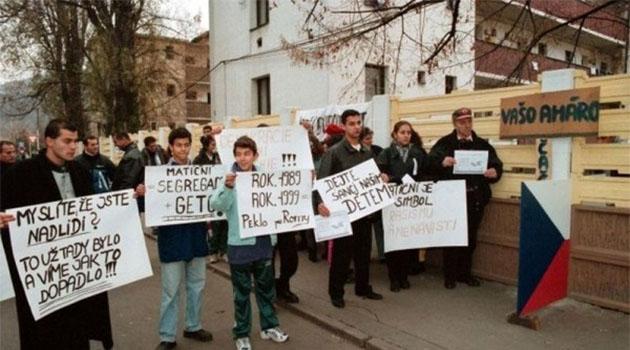Czech President Havel protested against the wall separating non-Roma from Roma on Matiční Street 20 years ago

Twenty years ago, on 13 October 1999, a concrete wall was installed on Matiční Street in the city of Ústí nad Labem. The barrier became an infamous example of problematic coexistence between neighbors in the Czech Republic.
The wall was meant to separate an area of single-family homes that were privately owned by non-Romani people from municipally-owned apartment buildings that were predominantly occupied by Romani people. Under pressure from the Czech Government, and after protests by human rights defenders both abroad and domestically, the barrier was disassembled six weeks later.
The Romani tenants had moved into the municipally-owned units on Matiční Street after moving away from other housing estates in the area in 1994. Their neighbors living in the single-family homes said coexistence with the newcomers was problematic and wrote up a petition demanding the building of a wall so they would not have to hear or see what they complained of as disorder and noise around the municipally-owned buildings.
The local municipal authority decided to accede to their wishes in September of 1998. That plan, however, sparked a response of rejection from the Czech Government, from then-President Václav Havel, and from international organizations.
After different delays and efforts by the Government and the lower house to prevent the building of the barrier, it began to be installed at the beginning of October 1999, replacing a previous construction made of iron. Romani protesters prevented the installation by dismantling it midway through, but the firm commissioned to the job reinstalled it completely on 13 October.
Under the influence of criticism from the European Union (of which the Czech Republic was not yet a member) and from the Government, the local assembly of Ústí nad Labem, after negotiating with newly-appointed Government Commissioner Pavel Zářecký, decided on 23 November to remove the barrier. It was dismantled the next day and the local assembly agreed to use a subsidy from the state to buy out the single-family homes of those residents who no longer wanted to remain in the neighborhood.
The entire case involved several lawsuits that dragged on for years, and today Matiční Street features residential housing that has not been maintained at all – one apartment building has already been demolished and the rest are bricked up. In 2009, the unfortunate concrete structure that had originally been intended for installation on Matiční Street found a new lease on life at the local Zoo.
